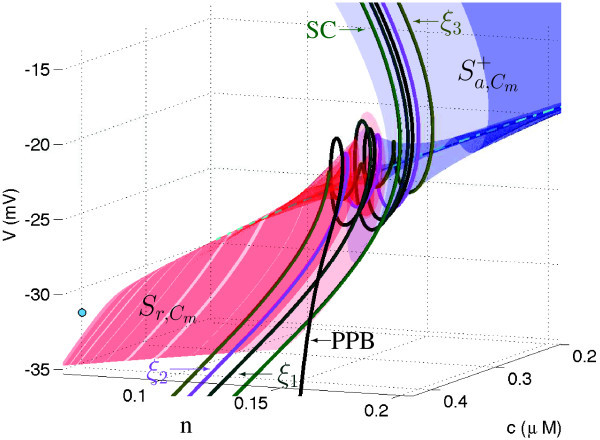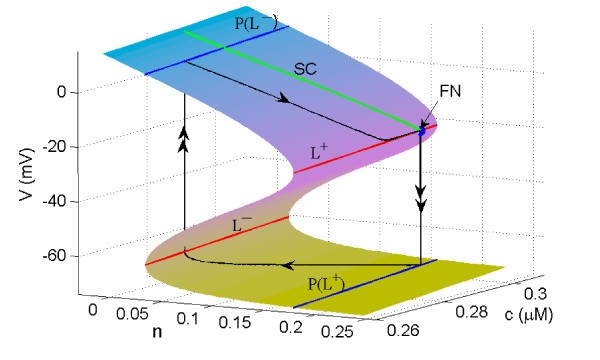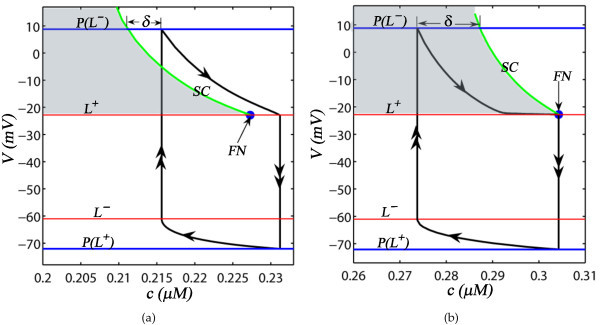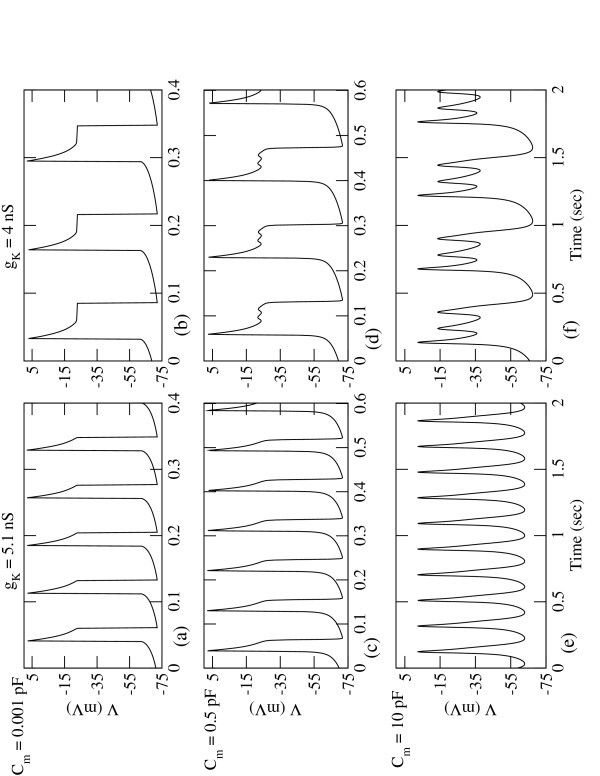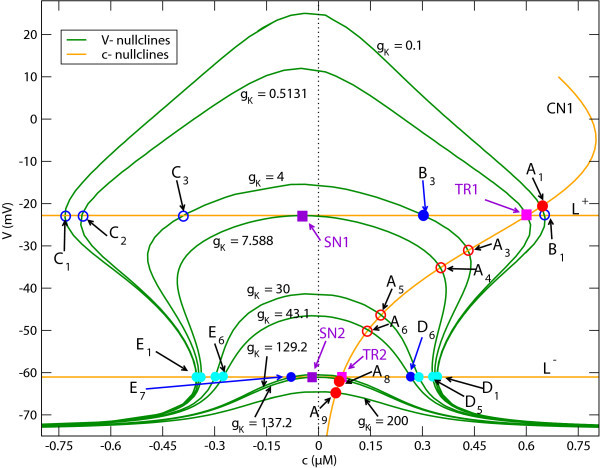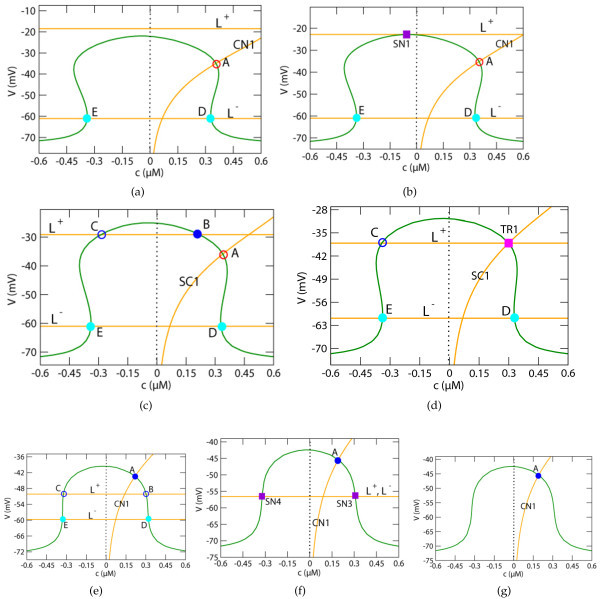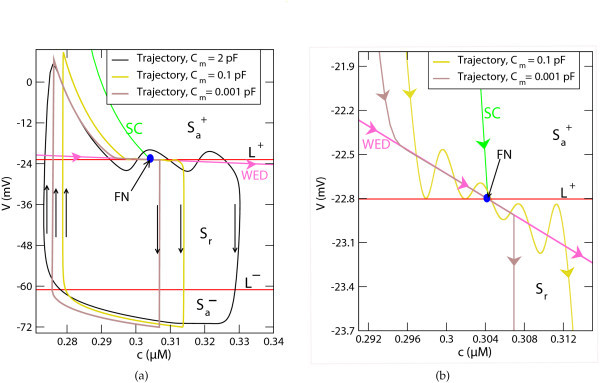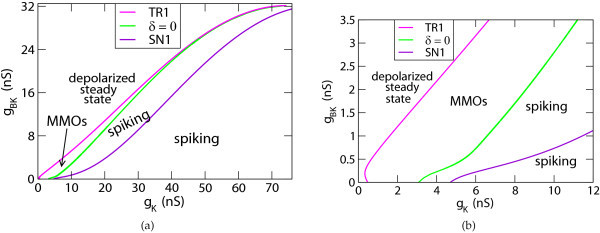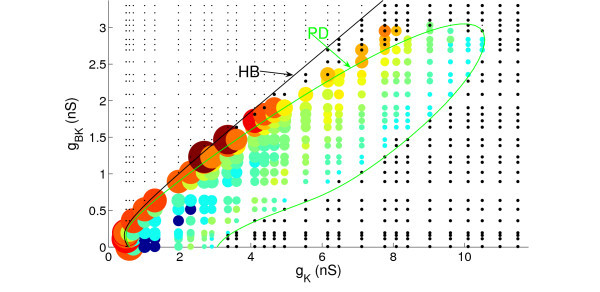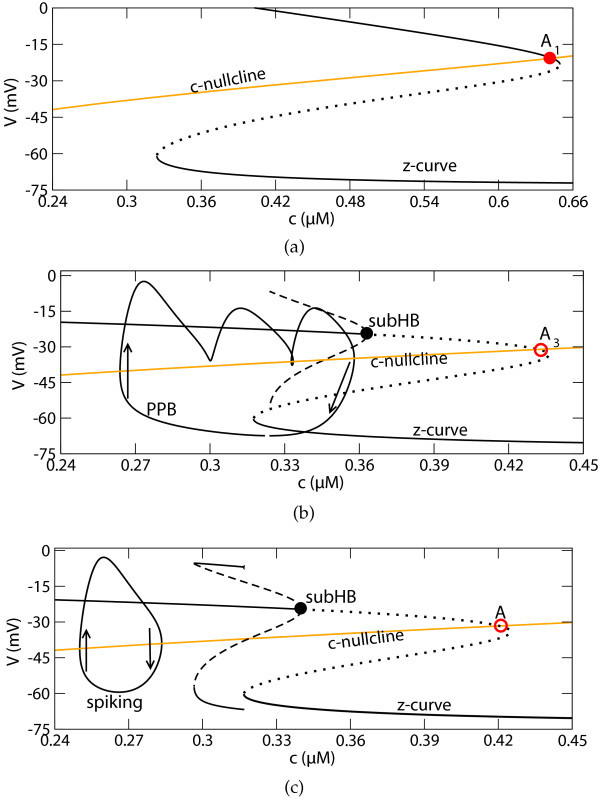Abstract
Pituitary cells of the anterior pituitary gland secrete hormones in response to patterns of electrical activity. Several types of pituitary cells produce short bursts of electrical activity which are more effective than single spikes in evoking hormone release. These bursts, called pseudo-plateau bursts, are unlike bursts studied mathematically in neurons (plateau bursting) and the standard fast-slow analysis used for plateau bursting is of limited use. Using an alternative fast-slow analysis, with one fast and two slow variables, we show that pseudo-plateau bursting is a canard-induced mixed mode oscillation. Using this technique, it is possible to determine the region of parameter space where bursting occurs as well as salient properties of the burst such as the number of spikes in the burst. The information gained from this one-fast/two-slow decomposition complements the information obtained from a two-fast/one-slow decomposition.
Keywords: Bursting, Mixed mode oscillations, Folded node singularity, Canards, Mathematical model
1 Introduction
Bursting is a common pattern of electrical activity in excitable cells such as neurons and many endocrine cells. Bursting oscillations are characterized by the alternation between periods of fast spiking (the active phase) and quiescent periods (the silent phase), and accompanied by slow variations in one or more slowly changing variables, such as the intracellular calcium concentration. Bursts are often more efficient than periodic spiking in evoking the release of neurotransmitter or hormone [1-3].
The endocrine cells of the anterior pituitary gland display bursting patterns with small spikes arising from a depolarized voltage [2-5]. Similar patterns have been observed in single pancreatic β-cells isolated from islets [6-8]. Figure 1(a) shows a representative example from a GH4 pituitary cell. Several mathematical models have been developed for this bursting type [5,8-10]. Prior analysis showed that the dynamic mechanism for this type of bursting, called pseudo-plateau bursting, is significantly different from that of square-wave bursting (also called plateau bursting) which is common in neurons [11-13]. Yet this analysis did not determine the possible number of spikes that occur during the active phase of the burst. The goal of this paper is to understand the dynamics underlying pseudo-plateau bursting, with a focus on the origin of the spikes that occur during the active phase of the oscillation.
Figure 1.
(a) Pseudo-plateau bursting in a GH4 pituitary cell line. (b) Plateau bursting in a neonatal CA3 hippocampal principal neuron. Reprinted with permission from [14].
Minimal models for pseudo-plateau bursting can be written as
| (1.1) |
| (1.2) |
| (1.3) |
where V is the membrane potential, n is the fraction of activated delayed rectifier K+ channels, and c is the cytosolic free Ca2+ concentration. The velocity functions are nonlinear, and ε1 and ε2 are parameters that may be small.
The variables V, n, and c vary on different time scales (for details, see Section 2). By taking advantage of time-scale separation, the system can be divided into fast and slow subsystems. In the standard fast/slow analysis one considers ε2 ≈ 0, so that V and n form the fast subsystem and c represents the slow subsystem. One then studies the dynamics of the fast subsystem with the slow variable treated as a slowly varying parameter [12,15-18]. This approach has been very successful for understanding plateau bursting, such as occurs in pancreatic islets [19], pre-Bötzinger neurons of the brain stem [20], trigeminal motoneurons [21] or neonatal CA3 hippocampal principal neurons [14], Figure 1(b). It has also been useful in understanding aspects of pseudo-plateau bursting such as resetting properties [11], how fast subsystem manifolds affect burst termination [17], and how parameter changes convert the system from plateau to pseudo-plateau bursting [12].
An alternate approach, which we use here, is to consider ε1 ≈ 0, so that V is the sole fast variable and n and c form the slow subsystem. With this approach, we show that the active phase of spiking arises naturally through a canard mechanism, due to the existence of a folded node singularity [22-25]. Also, the transition from continuous spiking to bursting is easily explained, as is the change in the number of spikes per burst with variation of conductance parameters. Thus, the one-fast/two-slow variable analysis provides information that is not available from the standard two-fast/one-slow variable analysis in the case of pseudo-plateau bursting.
2 The mathematical model
We use a model of the pituitary lactotroph, which produces pseudo-plateau bursting over a range of parameter values [10]. To achieve a minimal form, we use the model without A-type K+ current (IA). It includes three variables: V (membrane potential), n (fraction of activated delayed rectifier K+ channels), and c (cytosolic free Ca2+ concentration). The equations are:
| (2.1) |
| (2.2) |
| (2.3) |
where ICa is an inward Ca2+ current, IK is an outward delayed rectifying K+ current, IK(Ca) is a small-conductance Ca2+-activated K+ current, and IBK is a fast-activating large-conductance BK-type K+ current. The currents in the equations above are:
| (2.4) |
| (2.5) |
| (2.6) |
| (2.7) |
The steady state activation functions are given by:
| (2.8) |
| (2.9) |
| (2.10) |
| (2.11) |
Default parameter values are given in Table 1.
Table 1.
Parameter values for the lactotroph model.
| Parameter | Value | Description |
|---|---|---|
| Cm | 5 pF | Membrane capacitance of the cell |
| gCa | 2 nS | Maximum conductance of Ca2+ channels |
| VCa | 50 mV | Reversal potential for Ca2+ |
| νm | -20 mV | Voltage value at midpoint of m∞ |
| sm | 12 mV | Slope parameter of m∞ |
| gK | 4 nS | Maximum conductance of K+ channels |
| VK | -75 mV | Reversal potential for K+ |
| νn | -5 mV | Voltage value at midpoint of n∞ |
| sn | 10 mV | Slope parameter of n∞ |
| τn | 43 ms | Time constant of n |
| gK(Ca) | 1.7 nS | Maximum conductance of K(Ca) channels |
| Kd | 0.5 μM | c at midpoint of s∞ |
| gBK | 0.4 nS | Maximum conductance of BK-type K+ channels |
| νb | -20 mV | Voltage value at midpoint of f∞ |
| sb | 5.6 mV | Slope parameter of f∞ |
| fc | 0.01 | Fraction of free Ca2+ ions in cytoplasm |
| α | 0.0015 μM fC-1 | Conversion from charge to concentration |
| kc | 0.16 ms-1 | Rate of Ca2+ extrusion |
The variables V, n and c vary on different time scales. The time constant of V is given by τV = Cm/gTotal, where gTotal = gKn + gBKb∞(V) + gCam∞(V) + gK(Ca)s∞(c). During a bursting oscillation, the minimum of gTotal is 0.483 pS and the maximum is 3 pS. Hence, , or 1.7 ms ≤ τV ≤ 10.4 ms, for Cm = 5 pF, a typical capacitance value for lactotrophs. The time constant for n is τn = 43 ms. For the variable c, the time constant is ms = 625 ms. Thus, n and c change more slowly than V. This time scale separation between V and (c, n) can be accentuated when Cm is made smaller than the default 5 pF, i.e., when Cm → 0, τV gets smaller and V varies much faster. Thus, we can view the capacitance Cm as a representative of the dimensionless singular perturbation parameter ε1 in this model (Eq. 1.1).
All numerical simulations and bifurcation diagrams (both one- and two-parameter) are constructed using the XPPAUT software package [26], using the Runge-Kutta integration method, and computer codes can be downloaded from the following website: http://www.math.fsu.edu/~bertram/software/pituitary. The surface in Figure 9 was constructed using the AUTO software package [27]. All graphics were produced with the software package MATLAB.
Figure 9.
A portion of the twisted slow manifold for Cm = 2 pF, gK = 4 nS and gBK = 0.4 nS. The top attracting (, blue surface) and middle repelling (, red surface) sheets of the slow manifold are twisted around the blue dashed curve, which is the axis of rotation. The primary strong canard (SC, green) moves from the attracting to the repelling sheet without any rotations. The secondary canards ξ1 (gray curve, one rotation), ξ2 (purple curve, two rotations) and ξ3 (gold curve, three rotations) flow from the attracting to repelling sheet with different numbers of rotations. A portion of the pseudo-plateau burst trajectory (PPB, black curve) is superimposed and has two small oscillations. The full system has unstable equilibrium (cyan, filled curcle).
3 Geometric Singular Perturbation Theory
The reduced system
We consider the full system (Eqs. (2.1)-(2.3)) as having one fast variable V and two slower variables n and c. The time-scale separation can be accentuated by decreasing the singular perturbation parameter Cm. This facilitates analysis of the system dynamics [28]. In the limit Cm → 0, the trajectories of the system lie on a 2-D surface called the critical manifold. If we define the right hand side of Eq. (2.1) by
| (3.1) |
then the critical manifold is the surface S satisfying
| (3.2) |
The equation f(V, c, n) = 0 can be solved in explicit form for n as
| (3.3) |
The critical manifold (3.3) is a folded surface (Figure 2) that consists of three sheets separated by two fold curves (L- and L+). The lower and upper sheets are attracting () and the middle sheet is repelling (). The lower (L-) and upper (L+) fold curves are given by
Figure 2.
The critical manifold and fold curves with their projections for gK = 4 nS and gBK = 0.4 nS. The curves L- and L+ are the lower and upper fold curves, respectively. P(L-) and P(L+) are the projections of L- and L+ onto the upper and lower sheets of the critical manifold, respectively. FN is a folded node singularity, and SC (green curve) is the strong canard. The singular periodic orbit (black curve) is superimposed on the critical manifold.
| (3.4) |
This yields two constant V values and two equations for n in the form of n = n(c). Thus, the fold curves (L±) are (V±, c, n± (c)) where V- and V+ are constant V values. The curve L+ is projected vertically (along the fast variable V) onto the lower sheet to obtain the projection curve P(L+), and similarly for the (L-) projection onto the upper sheet. Figure 2 shows the critical manifold, the fold curves and the projections of the fold curves.
The reduced flow (when Cm → 0) is described by (3.3), the differential equation for c (Eq. (2.3)), and a differential equation for V which can be obtained by differentiating f(V, c, n) = 0 with respect to time. That is,
| (3.5) |
where n satisfies Eq. (3.3), and  ,
,  satisfy Eqs. (2.2), (2.3). The two differential equations for the reduced system are thus
satisfy Eqs. (2.2), (2.3). The two differential equations for the reduced system are thus
| (3.6) |
| (3.7) |
Since on L±, the reduced system is singular along the fold curves. The system can be desingularized by rescaling time with . The desingularized system is then
| (3.8) |
| (3.9) |
Defining
| (3.10) |
we have the desingularized system
| (3.11) |
| (3.12) |
The desingularized system describes the flow on the critical manifold. Because of the time rescaling, the flow on the middle sheet, where , must be reversed to obtain the equivalent reduced flow.
FoLded singuLarities and canards
Equilibria of the desingularized system are classified as ordinary singularities and folded singularities. An ordinary singularity is an equilibrium of Eqs. (2.1)-(2.3) and satisfies
| (3.13) |
| (3.14) |
| (3.15) |
A folded singularity lies on a fold curve (L+ or L-), and satisfies:
| (3.16) |
| (3.17) |
| (3.18) |
A folded singularity is classified as a folded node if the eigenvalues are real and have the same sign, a folded saddle if the eigenvalues are real and have opposite signs, or a folded focus if the eigenvalues are complex [22,23,25,29]. For parameter values used in Figure 2, the system has a folded node (with negative eigenvalues) on L+ (FN, blue point, in Figure 2), and a folded focus on L-(not shown).
There are an infinite number of singular trajectories on the top sheet that pass through the folded node (FN). These are called singular canards [22]. The singular canard that enters the FN in the direction of the strong eigenvector is called the strong canard (SC, green curve, in Figure 2). This curve and the fold curve L+ delimit the singular funnel that consists of all initial conditions whose trajectories for the reduced system pass through the folded node. The singular funnel and key curves are projected onto the (c, V)-plane in Figure 3. The different panels are obtained with different values of the parameter gK.
Figure 3.
The critical manifold is projected onto the (c, V)-plane for (a) gK = 5.1 nS, gBK = 0.4 nS and (b) gK = 4 nS, gBK = 0.4 nS. L- and L+ are the lower and upper fold curves, respectively. P(L-) and P(L+) are the projections of L- and L+. The shaded regions are singular funnels which are delimited by the curves L+ and the strong canards (SC, green curves). The singular periodic orbits (black curves with arrows) are superimposed. FN is a folded node singularity. δ < 0 in panel (a) and δ > 0 in panel (b).
Singular periodic orbits, relaxation oscillations, and mixed mode oscillations
A singular periodic orbit (Figure 2, black curve with arrows) can be constructed by solving the desingularized system for the flow on the top and bottom sheets of the critical manifold, and then projecting the trajectory from one sheet to the other along fast fibers when the trajectory reaches a fold curve. The singular periodic orbit is the closed curve constructed in this way. This process was discussed in detail in [22,28,30]. Briefly, the trajectory moves along the bottom sheet until L- is reached. At this point the reduced flow is singular (). The quasi-steady state assumption f(V, c, n) = 0 is no longer valid and there is a rapid motion away from the fold curve L-. This rapid motion is seen as vertical movement to the top sheet (the dynamics are governed by the layer problem, see [22,28]). The trajectory moves to a point on P(L-) and from there is once again governed by the desingularized equations, moving along the top sheet until L+ is reached. The fast vertical downward motion along fast fibers returns the trajectory to a point on P(L+) on the bottom sheet, completing the cycle.
When the singular periodic orbit reaches L- it jumps up to a point on P(L-). If this point on P(L-) is in the singular funnel, then the orbit will move through the FN. Otherwise it will not. Let δ denote the distance measured along P(L-) from the phase point on P(L-) of the singular periodic orbit to the strong canard (SC in Figure 3). When the phase point is on the strong canard, δ = 0. Let δ > 0 when the phase point is in the singular funnel and δ < 0 when the phase point is outside the singular funnel. Singular canards are produced when δ > 0.
In Figure 3(a) the singular periodic orbit jumps to a point on P(L-) outside of the singular funnel (δ < 0), so it does not enter the FN. This orbit is a relaxation oscillation [31]. In Figure 3(b)δ > 0, so the orbit is a singular canard. Away from the singular limit, this singular canard perturbs to an actual canard that is characterized by small oscillations about L+ [22]. The combination of these small oscillations with the large oscillations that occur due to jumps between upper and lower sheets yields mixed mode oscillations [24,32]. The small oscillations have zero amplitude in the singular case, which grows as for Cm sufficiently small [23]. A discriminating condition between relaxation and mixed mode oscillations is δ = 0, where the singular periodic orbit jumps to P(L-) on the SC curve.
When Cm > 0 the full system (Eqs.(2.1)-(2.3)) produces spiking for δ < 0 and mixed mode oscillations for δ > 0. Figure 4 shows these two different cases for gBK = 0.4 nS. For gK = 5.1 nS (δ < 0 in Figure 3(a)), the nearly-singular periodic orbit produced when Cm = 0.001 pF (Figure 4(a)) perturbs to continuous spiking when Cm = 10 pF (Figure 4(e)). When gK = 4 nS the singular periodic orbit enters the singular funnel (Figure 3(b)), so when Cm is increased the singular orbit transforms to mixed mode oscillations. For Cm = 0.5 pF mixed mode oscillations with small spikes are produced (Figure 4(d)). As Cm is increased to 10 pF, mixed mode oscillations with larger spikes are produced. This is the genesis of pseudo-plateau bursting (Figure 4(f)).
Figure 4.
Nearly-singular periodic orbits perturb to continuous spiking or mixed mode oscillations. In both cases gBK = 0.4 nS, and gK = 5.1 nS in the left column, gK = 4 nS in the right column. Cm is increased from top row to bottom row. (a), (c), (e) The singular periodic orbit does not enter the singular funnel (δ < 0) so it perturbs to continuous spiking. (b), (d), (f) The singular periodic orbit enters the singular funnel (δ > 0) so it perturbs to mixed mode oscillations or pseudo plateau bursting.
4 Analysis of the desingularized system and folded nodes
We next discuss the singularities of the desingularized system for a range of gK and gBK values (Figure 5). The system (with gBK = 0.4 nS) has a single-branched V-nullcline (green curve) that satisfies F(V, c, n) = 0 and a three-branched c-nullcline (orange curves) L-, L+ and CN1. The curves L-, L+ satisfy , and are the same as the fold curves in Figure 3. The curve CN1 satisfies αICa + kc = 0. There are folded singularities that are located at intersections of the V-nullcline with L- or L+, and ordinary singularities that are located at intersections with CN1. For fixed gBK, changing gK affects the position of the V-nullcline but not the c-nullcline.
Figure 5.
V-nullclines (green), the three-branched c-nullcline (orange), and singularities for gBK = 0.4 nS and different values of gK (units in nS). Filled circles represent stable singularities and unfilled circles represent unstable singularities. Red circles (filled or unfilled) are ordinary singularities. Filled and unfilled circles in blue are folded nodes and folded saddles, respectively. Filled circles in cyan are folded foci. The points TR1 and TR2 are transcritical bifurcations (type II folded saddle-node bifurcations) and SN1 and SN2 are standard saddle-node bifurcations (type I folded saddle-node bifurcations).
For values gK < 0.5131 nS, there is a stable node on CN1 (A1), which would be on the top sheet of the critical manifold. There are also two folded saddles on L+ (B1 and C1) and two folded foci on L- (D1 and E1). When gK is increased to 0.5131 nS the stable node A1 moves down and to the left and the folded saddle B1 moves to the left. These two equilibria coalesce at a transcritical bifurcation (TR1). This transcritical bifurcation corresponds to a bifurcation of folded singularities called a type II folded saddle-node [22,30,33]. Following this bifurcation, the folded singularity is a folded node. For gK = 4 nS, the equilibria on L+ are the folded node (B3) and the folded saddle (C3). The equilibrium on CN1 (A3) is now a saddle point. There is no qualitative change of equilibria on L-.
When gK is increased to 7.588 nS the equilibria B3 and C3 coalesce at a saddle-node bifurcation point (SN1). This is a standard saddle-node bifurcation of folded singularities and is called a type I folded saddle-node [22,30,33]. As gK is increased to 43.1 nS, the folded focus D5 moves to the left and changes to a folded node at D6. The saddle points on CN1 move downward and to the left as gK is increased. For gK = 129.2 nS, the saddle point A6 coalesces with the fold node D6 at a second transcritical bifurcation (TR2); again a type II folded saddle-node. Beyond this, the ordinary singularity (A8, A9) is stable and the folded singularity becomes a folded saddle. Moreover the folded focus E6 has become a folded node (E7). As gK is increased further to 137.2 nS, there is a second type I saddle-node bifurcation (SN2) at which the folded node and the folded saddle coalesce and disappear. For the values gK > 137.2 nS, the only equilibrium is on CN1 and is an ordinary stable node (A9). This is on the bottom sheet of the critical manifold.
Varying gBK slightly affects the V-nullcline and strongly affects the c-nullcline in the (c, V)-phase plane. Increasing gBK moves the fold curves together, eventually taking the fold out of the critical manifold. Figure 6 shows qualitative changes in the equilibria when gBK is varied, with gK = 7.588 nS. When gBK = 0.2 nS there is a saddle point on CN1 (A) and two folded foci (D and E) on L- (Figure 6(a)). When gBK is increased to 0.4 nS, the curve L+ moves down and a type I folded saddle-node bifurcation occurs (SN1 in Figure 6(b)). When gBK is increased further, the saddle-node splits into a folded node (B) and a folded saddle (C) on L+, as shown for gBK = 1 nS in Figure 6(c).
Figure 6.
V-nullclines (green), c-nullclines (orange) and ordinary and folded singularities for a range of gBK values with gK = 7.588 nS. (a) gBK = 0.2 nS, (b) gBK = 0.4 nS, (c) gBK = 1 nS, (d) gBK = 3.96 nS, (e) gBK = 20 nS, (f) gBK = 32.1224 nS, and (g) gBK = 32.2 nS. The color convention for equilibria is as in Fig. 5.
The folded node (B) and the saddle point (A) coalesce at a transcritical bifurcation (type II folded saddle-node) when gBK = 3.96 nS (TR1 in Figure 6(d)). Beyond this, the ordinary singularity (A) is a stable node that lies on the top sheet of the critical manifold. When gBK = 20 nS the folded singularities are either saddles or foci, Figure 6(e). For gBK ≈ 32.12 nS the two folded foci on L-change to folded nodes. Finally, when gBK is increased to 32.1224 nS, the fold curves L+ and L- merge. As a result, the folded saddles coalesce with the folded nodes at type I folded saddle-node bifurcations (SN3 and SN4 in Figure 6(f)). Beyond this, there is only a stable node (A in Figure 6(g)). The disappearance of the L+ and L- curves correspond to the disappearance of the fold in the critical manifold.
The two-parameter bifurcation diagram in Figure 7 summarizes the variations of the bifurcations in Figure 5 and Figure 6 over a range of gK and gBK values. The curves TR1 and TR2 correspond to the transcritical bifurcations (type II folded saddle-node bifurcations), and SN1-SN4 correspond to the saddle-node bifurcations (type I folded saddle-node bifurcations). At gBK = 32.1224 nS the L+ and L- lines coalesce into a single line. This contains the SN3 and SN4 bifurcations, up until SN3 and SN4 coalesce at a codimension-2 bifurcation (for gK = 83.7122 nS). For large gK, the L+/L- line contains no folded singularities (dashed line).
Figure 7.
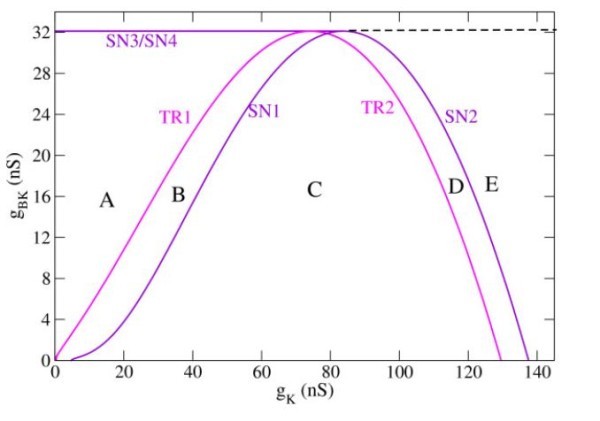
Two-parameter bifurcation structure for the desingularized system. The curves TR1 and TR2 represent the transcritical bifurcations (type II folded saddle-nodes). The curves SN1-SN4 represent saddle-node bifurcations (type I folded saddle-nodes). The horizontal line is where the fold curves L+ and L- coalesce. A codimension-2 bifurcation occurs at the intersection of the SN curves.
For gK and gBK values in regions A, D and E there is only a stable node and the full system is in a depolarized (A) or hyperpolarized (D or E) steady state. In the left portion of region C there is a folded focus which becomes a folded node in the right portion of C. This family of folded singularities is on L-. In region D there is a folded node on L- for negative values of c. Region B consists of the folded nodes on L+, and it is the key region for the existence of mixed mode oscillations, since δ > 0 for much of this region (shown below).
5 Twisted slow manifolds and secondary canards
The folded nodes discussed above are important since they yield small oscillations (for Cm > 0) in all trajectories entering the singular funnel. In this section we explain the genesis of those oscillations (for more details, see [22,23,28,32]).
Folded nodes or saddles are characterized by the ratio of their eigenvalues. Let λ1 and λ2 be the eigenvalues of the folded singularity on the fold curve L+ such that | λ1| < | λ2|. Define μ as
| (5.1) |
In region A of Figure 7, which consists of folded saddles, μ < 0. On the TR1 curve μ = 0 since λ1 = 0. Folded nodes occur in region B, so μ > 0. For Cm > 0, but small, a trajectory approaching a folded node will oscillate, due to twists in the attracting and repelling sheets of the slow manifold. The maximum number of oscillations is given by [23,32]
| (5.2) |
which is the greatest integer less than or equal to . At a point in region B and close to the TR1 curve in Figure 7, μ > 0 but small. Hence, Smax is large. Similarly on SN1 μ = 0, so in region B and close to the SN1 curve μ > 0 and small, so Smax is large. Between these curves μ increases and Smax declines. This is shown in Figure 8 for the case gBK = 0.4 pS. The small value of μ over the full range of gK values in (Figure 8a) suggests the system is close to a folded saddle-node bifurcation, either type I (SN1) or type II (TR1).
Figure 8.
The effects of varying gK on the eigenvalue ratio (μ) and the maximum number of oscillations (Smax) for gBK = 0.4 nS. (a) μ = 0 at TR1 and SN1. (b) Smax is largest near the bifurcation points.
The attracting sheets of the critical manifold (Sa) and the repelling middle sheet (Sr) come together at the fold curves L+ and L-. For Cm > 0, Fenichel theory [34] tells us that the critical manifold perturbs smoothly to invariant attracting and repelling () manifolds away from L+ and L-. However, the critical manifold is non-hyperbolic on L+ and L-, and perturbs to twisted sheets near these curves to preserve uniqueness of solutions [23,35]. Figure 9 shows how the top attracting (blue) and middle repelling (red) sheets of the slow manifold intersect and twist. The numerical method used to compute the slow manifolds was developed by Desroches et al. [36,37].
The primary weak canard corresponds to the weak eigendirection of the folded node. It is at the intersection of the invariant manifolds and and serves as their axis of rotation. All other canards twist about the primary weak canard; they follow as it twists and then follow for a distance as it twists. The primary strong canard, which corresponds to the strong eigendirection of the folded node, moves along to without any rotation (SC, green curve in Figure 9). Other, secondary, canards rotate a number of times, depending on how close they are to the primary strong canard. A secondary canard that makes k small rotations in the vicinity of the folded node is called the kth secondary canard. Figure 9 shows the first (ξ1, gray), second (ξ2, purple) and third (ξ3, olive) secondary canards that make one, two and three rotations, respectively. For Cm > 0, but small, there are Smax - 1 secondary canards which divide the funnel region between the primary canards into Smax subsectors [24]. The first subsector is bounded by the strong canard SC and the first secondary canard ξ1 and trajectories entering here have one rotation. The second subsector is bounded by ξ1 and ξ2 and trajectories entering here have two rotations. The last subsector is bounded by the last secondary canard and the primary weak canard. The maximal rotation number is achieved in the last subsector; trajectories entering here have Smax rotations [23,28,32].
Figure 9 also shows a portion of the pseudo-plateau burst trajectory (PPB, black curve) for Cm = 2 pF. It enters the funnel region in the rotational subsector bounded by ξ1 and ξ2, and hence, makes two full rotations and then leaves the repelling sheet as it moves towards the lower attracting manifold . These rotations are the small oscillations or "spikes" during the burst active phase.
Figure 10(a) shows burst trajectories for three values of Cm projected onto the (c, V)-plane. Also shown are L+, L-, the singular strong canard SC and the folded node of the desingularized system. Finally, the line along the weak eigendirection of the folded node is included (WED, pink curve). With Cm = 0.001 pF the system is nearly singular and the "bursting" trajectory enters and leaves the folded node along the WED. The small oscillations near the folded node are too small to see. The region near the folded node is magnified in Figure 10(b). With Cm = 0.1 pF the burst trajectory again passes through the folded node along the WED, but now the small oscillations are visible in Figure 10(b). The small oscillations of this burst trajectory first decrease and then increase in amplitude. This is often seen in mixed mode oscillations that are associated with a folded node singularity, in contrast to those associated with a singular Hopf bifurcation, where the amplitude of successive small oscillations increases [38]. Finally, with Cm = 2 pF (the value used in Figure 9) the small oscillations are prominent even in the larger vertical scale used in Figure 10(a).
Figure 10.
(a) Pseudo-plateau burst trajectories are projected onto the (c, V)-plane for gK = 4 nS and gBK = 4 nS, and different values of Cm. Key structures from the desingularized system are also shown. WED (pink curve) is the line tangent to the weak eigendirection of the folded node. (b) Magnification of panel (a) in the vicinity of the weak eigendirection and fold curve L+.
6 The boundaries of mixed mode oscillations
For a periodic mixed mode oscillation (i.e., pseudo-plateau bursting) solution to exist, there must be a folded node singularity and the periodic orbit must enter the funnel. In this section we construct curves in the two-parameter gK-gBK plane that form boundaries for the existence of mixed mode oscillations.
From Figure 7 we know that folded node singularities only occur in regions B and C (and in region D for negative values of the Ca2+ concentration). Those in region C occur on L- and the periodic orbit never enters the corresponding singular funnel. We therefore focus on region B. This region is highlighted in Figure 11(a). Above the TR1 curve the system has a depolarized stable steady state. Below the SN1 curve the system spikes continuously. Between these curves a folded node singularity exists, and the requirement for periodic mixed mode oscillations is that δ > 0. That is, the singular orbit must enter the singular funnel. Thus, the final curve delimiting the MMOs region is δ = 0 (the set of gK and gBK values at which the singular periodic orbit intersects both the strong canard and the curve P(L-)), shown in green in Figure 11. For parameter values between the δ = 0 and TR1 curves periodic mixed mode oscillations, i.e., pseudo-plateau bursting, exist and are stable. This critical region is magnified in Figure 11(b).
Figure 11.
(a) Mixed mode oscillation borders for Cm → 0. The region of mixed mode oscillations (MMOs) is bounded by the two curves TR1 and δ = 0. Steady state and spiking solutions occur to the left of the TR1 curve and to the right of the δ = 0 curve, respectively. (b) Magnification of panel (a) for a smaller range of values of gK and gBK.
Figure 12 shows how the burst duration and the number of spikes in a burst vary over a range of gK and gBK values for Cm = 5 pF. A similar map of parameter space was used previously in the analysis of a parabolic burster [39]. Two-parameter bifurcation curves of the full system (Eqs. (2.1)-(2.3)) are also shown. These include a curve of supercritical Hopf bifurcations (HB, black) and a curve of period doublings (PD, green). To the left of the HB curve the system is at a steady state (black dots), and to the right of and above the PD curve the system produces continues spiking (small black circles). For the values of gK and gBK inside the PD curve the system produces pseudo-plateau bursting oscillations (MMOs), represented by colored circles.
Figure 12.
The active phase duration and the number of spikes per burst of the full system for Cm = 5 pF. The system displays steady state, spiking or bursting solutions. Steady state and spiking solutions are represented by black dots and small black circles, respectively. The bursting region is bounded by the supercritical Hopf bifurcation (HB, black) and the right branch of the period doubling (PD, green) curves. The bursting patterns in this region are represented by colored circles. The size of a circle represents the active phase duration, with larger circles corresponding to longer active phase durations. The color of a circle represents the number of spikes per burst. Cyan circles correspond to smaller number of spikes per burst (minimum of two spikes) and the largest dark red circle corresponds to the largest number of spike per burst (36 spikes in a burst).
In the bursting region the active phase duration and the number of spike per burst vary with respect to the values of gK and gBK. The size of each circle represents the active phase duration, and the color of the circle (from cyan to dark red) represents the number of spikes in a burst. A burst with larger number of spikes has longer active phase duration, and in an actual cell this determines the amount of Ca2+ influx and hormone released. The bursts that have the shorter active phase duration and the smaller number of spikes occur near the right branch of the PD curve. These bursts are represented by smaller cyan circles in Figure 12. For example, when gBK = 1 nS and gK = 6 nS the system produces bursting oscillations with three spikes per burst (as in Figure 4(f)). When one moves away from the right to the left branch of the PD curve by increasing gBK or decreasing gK the burst duration becomes longer and the number of spikes in a burst becomes larger. The longest active phase duration is about 8.4 sec and the largest number of spikes per burst is about 36, represented by the largest dark red circle. These values will change when Cm is changed.
The region between the HB and the left branch of the PD curves is bistable between bursting and continuous spiking. Orange circles with small black circles at the centers represent bistable solutions that are simulated by varying the initial conditions. This shows that the borders of the bursting region are the HB and the right branch of the PD curves. The dark blue circles represent bursting oscillations without small oscillations since the amplitudes of the spikes are almost zero, i.e., the small oscillations are too small to see.
The results that are shown in Figure 12 are very consistent with the analysis of the mixed mode oscillations in Figure 11. The HB and TR1 curves overlap, demonstrating that for small Cm the HB of the full system corresponds to a type II saddle-node bifurcation of the desingularized system. Also, the HB curve and the left branch of the PD curve are almost indistinguishable for small Cm. For these Cm values (Cm < 0.001 pF), the right branch of the PD curve converges to the δ = 0 curve of the desingularized system. Hence, the left and right borders of the MMOs in the singular limit Cm → 0 pF correspond to the left and right borders of the bursting region of the full system for Cm > 0, with the exception that the bursting region is smaller for larger values of Cm. Also, the bistable region between the PD and HB curves only exists as the left PD moves away from the HB, which occurs as Cm is increased.
In Figure 11 the MMOs region delimited by the TR1 and δ = 0 curves can be divided into subregions that have different numbers of small oscillations. For parameter values in the subregion near the curve δ = 0 the periodic orbit enters the funnel region near the strong (primary) canard. This subregion corresponds to the first subsector of the funnel region, and for Cm > 0 only one small oscillation occurs in a burst. This corresponds to the jump from the lower attracting sheet to the upper attracting sheet and is not due to the folded node. When one moves leftward by decreasing gK, δ increases and the periodic orbit enters the funnel region through other subsectors. As a result, the number of small oscillations in a burst increases. When one moves to the subregion near or on the TR1 curve by decreasing gK further, the periodic orbit enters the funnel region through the last subsector. The number of small oscillations is closer to Smax, the maximum number of spikes in a burst as determined by the eigenvalues of the folded node. Moreover, increasing gBK has the same effect as decreasing gK. These trends in the number of small oscillations obtained from an analysis of the desingularized system [28] are expressed far from the singular limit as shown in Figure 12 where Cm = 5 pF. Here the longest bursts occur near the HB curves, as predicted.
7 A comparison with a two-fast/one-slow variable analysis
Using a one-fast/two-slow variable analysis we have shown the genesis of the spikes in a burst and how the number of spikes in a burst varies in the gK-gBK parameter space. The regions for steady states, pseudo-plateau bursting (mixed mode oscillations) and spiking are clearly identified in this parameter space (Figure 11). This has been done by investigating the qualitative changes of the desingularized system when parameters gK (Figure 5) and gBK (Figure 6) are varied, which are summarized in Figure 7.
Here we investigate whether this information can be obtained from a standard two-fast/one-slow variable analysis. Figure 13(a) shows a bifurcation diagram of the V-n fast subsystem with c treated as a parameter (referred to as a "z-curve"). The subsystem is bistable over a large range of c values, with stable depolarized and hyperpolarized steady states, separated by saddle points. The c-nullcline is superimposed, now thinking of c as a slowly-changing variable rather than as a parameter. This is the standard approach used in a two-fast/one-slow variable analysis. In all three panels of Figure 13 parameters are set at gBK = 0.4 nS, Cm = 10 pF, and gK is varied.
Figure 13.
Two-fast/one-slow analysis for gBK = 0.4 nS, Cm = 10 pF and different values of gK. The black "z-curve" is the curve of equilibria of the V-n fast subsystem. This has stable (solid) and unstable (dashed) branches. (a) gK = 0.1 nS, the full system with stable equilibrium (A1) is in a depolarized steady state. (b) gK = 4 nS, the fast subsystem has an unstable limit cycle that emerges from the subcritical Hopf bifurcation (subHB). Pseudo-plateau bursting (PPB, black trajectory) is produced. The equilibrium of the full system (A3) is unstable. (c) gK = 5.1 nS, the full system produces periodic spiking that appears unrelated to the fast subsystem bifurcation structure. The equilibrium point of the full system (A) is unstable. In all panels the system is bistable over a range of c-values. The points A1 and A3 are the same equilibrium points as A1 and A3 in Fig. 5, respectively.
In Figure 13(a), with gK = 0.1 nS, there is an intersection of the c-nullcline on the upper stable branch at location A1. This is a stable equilibrium of the full 3-dimensional system, and corresponds to A1 in the analysis shown in Figure 5. Thus, both types of analysis indicate that the system will come to rest at a depolarized steady state when gK = 0.1 nS.
When gK is increased there is a subcritical Hopf bifurcation on the upper branch with emergent unstable periodic solutions of the fast-subsystem. This is shown in Figure 13(b) for the case gK = 4 nS. Pseudo-plateau bursting occurs for this and nearby values of gK. The full system unstable equilibrium (A3) corresponds to A3 in Figure 5.
The superimposed burst trajectory in Figure 13(b) only weakly follows the fast-subsystem bifurcation diagram. Most notably, there are no stable periodic solutions of the fast subsystem, only bistability between two steady states. Also, the trajectory never follows the lower branch of stationary solutions and greatly overshoots the lower knee.
The subcritical Hopf bifurcation migrates leftward when gK is increased to 5.1 nS. The unstable branch of periodics goes through a saddle-node bifurcation, yielding a branch of stable periodic solutions of the fast subsystem (Figure 13(c)). There is bistability between upper and lower branches of the z-curve which is typically a necessary condition for bursting with this type of analysis. However, bursting is not produced for this value of gK. Instead, the system spikes continuously.
This example illustrates that features well described by the one-fast/two-slow variable analysis are not at all well described by a standard two-fast/one-slow variable analysis. Most notably, the transition from bursting to spiking is well characterized in the one-fast/two-slow variable analysis as the point at which δ = 0. Note that this is not a bifurcation point of the desingularized system, but reflects the jump point from the lower sheet of the slow manifold to the the upper sheet. In contrast, the bursting to spiking transition is not predicted from the two-fast/one-slow analysis, and indeed the periodic spiking trajectory of the full system occurs over a range of the fast-subsystem bifurcation diagram that contains only stable equilibria. The one-fast/two-slow approximation is good even at higher values of Cm, for example, when Cm = 5 pF (Figure 12). Similar remarks apply for smaller values of Cm, where the one-fast/two-slow approximation becomes more accurate while the two-fast/one-slow approximation does not. The two-fast/one-slow approximation becomes more accurate when c is much slower than both V and n, but in this case only a stable steady solution or a relaxation oscillation is produced.
8 Discussion
The canard mechanism has been used to understand mixed mode oscillations in several neuronal models [30,37,40-44]. In these examples, the small oscillations correspond to subthreshold oscillations that occur between the electrical impulses. We have previously analyzed pseudo-plateau bursting in a pituitary lactotroph model using canard theory [28]. However, the model used was a simplification in which the cytosolic free Ca2+ concentration was treated as a fixed parameter and the second slow variable (in addition to the variable n used here) was an inactivation variable for an A-type K+ current. In the current paper, we again focused on pseudo-plateau bursting in a pituitary lactotroph model, but now with emphasis on a BK-type K+ current. In this analysis, we have examined the effects of changing the parameters Cm, gK and gBK. The parameter gBK is important for producing bursting oscillations in actual pituitary cells in which bursting is converted to spiking when BK-type K+ channels are blocked [45].
Here, using Cm to control the separation in time scales, we identified two slow variables (n, c) and one fast variable (V). Using the one-fast/two-slow variable analysis we showed that pseudo-plateau bursting is a canard-induced mixed mode oscillation. There are two main requirements for the existence of these bursting oscillations [22-24,32]. One is that the desingularized system must have a folded node singularity, i.e., the eigenvalue ratio (μ) has to be positive. The second requirement is that the singular periodic orbit should enter the singular funnel and pass through the folded node, i.e., δ should be positive. In short, canard-induced mixed mode oscillations exist if both μ and δ are positive.
Using this technique we can understand several features of the burst and several trends that occur as parameters are varied. When both μ and δ are positive, small oscillations are produced during the active phase of a burst and their amplitude is proportional to for Cm sufficiently small [23]. We obtained the bursting borders in the (gK, gBK)-plane (Figure 11 and 12), and predicted how the active phase duration and the number of spikes per burst vary with changes in parameters.
The singular perturbation analysis performed here is technically more effective and informative in the singular limit (i.e., for sufficiently small values of Cm) [22,23]. However, it provides useful information even far from this limit, as we showed in Figures 11 and 12. Eventually, as the singular parameter (Cm) is increased sufficiently, new dynamics will be introduced, and the insights from the singular analysis are no longer valid.
The one-fast/two-slow decomposition used here contrasts with the two-fast/one-slow variable analysis used previously for pseudo-plateau bursting [10-13]. Our analysis explains the origin of the small-amplitude spikes that occur during the active phase of pseudo-plateau bursting, the transition between spiking and bursting, and information about how the number of spikes per burst varies with parameters. While the two-fast/one-slow variable analysis provides little information on these things, it does provide valuable information about how one can make a transition between plateau and pseudo-plateau bursting as one or more parameters are changed [12]. It also provides information about complex phase resetting properties [11] and the termination of spikes in a burst [17]. Both fast/slow decompositions are approximations, however, to a system that evolves on three time scales. Some studies [13,17,18] focus on the dynamics of the full system, and illustrate the complexity of the seemingly simple set of equations. The advantage of obtaining useful information of the full system by a two-fast/one-slow or one-fast/two-slow decomposition points to the fact that system (2.1)-(2.3) actually evolves on three time scales: V fast, n intermediate and c slow. This can also be seen by the magnitude of μ which is bounded from above by μmax ≈ 0.07 (Figure 8(a)). Hence, we are close to folded saddle-node regimes (type I and type II) [33,38] and a more detailed bifurcation analysis may explain the relation between the two-fast/one-slow and one-fast/two-slow splitting. This is left for future work.
Competing interests
The authors declare that they have no competing interests.
Authors' contributions
WT, JT, TV, MW, and RB performed the analysis. WT wrote the manuscript with assistance from JT, TV, MW, and RB. All authors read and approved the final manuscript.
Contributor Information
Wondimu Teka, Email: wteka@math.fsu.edu.
Joël Tabak, Email: joel@neuro.fsu.edu.
Theodore Vo, Email: thvo4579@mail.usyd.edu.au.
Martin Wechselberger, Email: wm@maths.usyd.edu.au.
Richard Bertram, Email: bertram@math.fsu.edu.
Acknowledgements
This work was supported by NSF grant DMS 0917664 to RB and NIH grant DK 043200 to RB and JT.
References
- Lisman JE. Bursts as a unit of neural information: making unreliable synapses reliable. Trends Neurosci. 1997;20:38–43. doi: 10.1016/S0166-2236(96)10070-9. [DOI] [PubMed] [Google Scholar]
- Van Goor F, Zivadinovic D, Martinez-Fuentes AJ, Stojilkovic SS. Dependence of pituitary hormone secretion on the pattern of spontaneous voltage-gated calcium influx. Cell type-specific action potential secretion coupling. J Biol Chem. 2001;276:33840–33846. doi: 10.1074/jbc.M105386200. [DOI] [PubMed] [Google Scholar]
- Stojilkovic SS, Zemkova H, Van Goor F. Biophysical basis of pituitary cell type-specific Ca2+ signaling-secretion coupling. Trends Endocrino L Metabol. 2005;16:152–159. doi: 10.1016/j.tem.2005.03.003. [DOI] [PubMed] [Google Scholar]
- Kuryshev YA, Childs GV, Ritchie AK. Corticotropin-releasing hormone stimulates Ca2+ entry through L- and P-type Ca2+ channels in rat corticotropes. Endocrinology. 1996;137:2269–2277. doi: 10.1210/en.137.6.2269. [DOI] [PubMed] [Google Scholar]
- Tsaneva-Atanasova K, Sherman A, Van Goor F, Stojilkovic SS. Mechanism of spontaneous and receptor-controlled electrical activity in pituitary somatotrophs: experiments and theory. J Neurophysiol. 2007;98:131–144. doi: 10.1152/jn.00872.2006. [DOI] [PubMed] [Google Scholar]
- Falke LC, Gillis KD, Pressel DM, Misler S. Perforated patch recording allows long-term monitoring of metabolite-induced electrical activity and voltage-dependent Ca2+ currents in pancreatic islet β cells. FEBS Lett. 1989;251:167–172. doi: 10.1016/0014-5793(89)81448-6. [DOI] [PubMed] [Google Scholar]
- Kinard T, Vries GD, Sherman A, Satin LS. Modulation of the bursting properties of single mouse pancreatic beta-cells by artificial conductances. Biophys J. 1999;76(3):1423–1435. doi: 10.1016/S0006-3495(99)77303-0. [DOI] [PMC free article] [PubMed] [Google Scholar]
- Zhang M, Goforth P, Bertram R, Sherman A, Satin L. The Ca2+ dynamics of isolated mouse β-cells and islets: implications for mathematical models. Biophys J. 2003;84:2852–2870. doi: 10.1016/S0006-3495(03)70014-9. [DOI] [PMC free article] [PubMed] [Google Scholar]
- LeBeau AP, Robson AB, McKinnon AE, Sneyd J. Analysis of a reduced model of corticotroph action potentials. J Theor Biol. 1998;192:319–339. doi: 10.1006/jtbi.1998.0656. [DOI] [PubMed] [Google Scholar]
- Tabak J, Toporikova N, Freeman ME, Bertram R. Low dose of dopamine may stimulate prolactin secretion by increasing fast potassium currents. J Comput Neurosci. 2007;22:211–222. doi: 10.1007/s10827-006-0008-4. [DOI] [PMC free article] [PubMed] [Google Scholar]
- Stern JV, Osinga HM, LeBeau A, Sherman A. Resetting behavior in a model of bursting in secretory pituitary cells: distinguishing plateaus from pseudo-plateaus. Bull Math Biol. 2008;70:68–88. doi: 10.1007/s11538-007-9241-x. [DOI] [PubMed] [Google Scholar]
- Teka W, Tsaneva-Atanasova K, Bertram R, Tabak J. From plateau to pseudo-plateau bursting: making the transition. Bulletin of Mathematical Biology. 2011;73(6):1292–1311. doi: 10.1007/s11538-010-9559-7. [DOI] [PMC free article] [PubMed] [Google Scholar]
- Tsaneva-Atanasova K, Osinga HM, Riess T, Sherman A. Full system bifurcation analysis of endocrine bursting models. J Theor Biol. 2010;264:1133–1146. doi: 10.1016/j.jtbi.2010.03.030. [DOI] [PMC free article] [PubMed] [Google Scholar]
- Safiulina VF, Zacchi P, Taglialatela M, Yaari Y, Cherubini E. Low expression of Kv7/M channels facilitates intrinsic and network bursting in the developing rat hippocampus. J Physiol. 2008;586(22):5437–5453. doi: 10.1113/jphysiol.2008.156257. [DOI] [PMC free article] [PubMed] [Google Scholar]
- Rinzel J. In: Mathematical Topics in Population Biology, Morphogenesis, and Neurosciences, Lecture Notes in Biomathematics. Teramoto E, Yamaguti M, editor. Springer, Berlin; 1987. A formal classification of bursting mechanisms in excitable systems; pp. 267–281. [Google Scholar]
- Rinzel J, Ermentrout GB. In: Methods in Neuronal Modeling: From Synapses to Networks. 2. Koch C, Segev I, editor. Cambridge, MA,: MIT Press; 1998. Analysis of neural excitability and oscillations; pp. 251–292. [Google Scholar]
- Nowacki J, Mazlan S, Osinga HM, Tsaneva-Atanasova K. The role of large-conductance calcium-activated K+ (BK) channels in shaping bursting oscillations of a somatotroph cell model. Physica D. 2010;239:485–493. doi: 10.1016/j.physd.2009.11.014. [DOI] [Google Scholar]
- Osinga HM, Tsaneva-Atanasova K. Dynamics of plateau bursting depending on the location of its equilibrium. J Neuroendocrinol. 2010;22(12):1301–1314. doi: 10.1111/j.1365-2826.2010.02083.x. [DOI] [PubMed] [Google Scholar]
- Bertram R, Sherman A. In: The Genesis of Rhythm in the Nervous System. Coombes S, Bressloff P, editor. World Scientific Press, New Jersey; 2005. Negative calcium feedback: the road from Chay-Keizer; pp. 19–48. [Google Scholar]
- Butera RJ, Rinzel J, Smith JC. Models of respiratory rhythm generation in the pre-Bötzinger complex. I. Bursting pacemaker neurons. J Neurophysiol. 1999;82:382–397. doi: 10.1152/jn.1999.82.1.382. [DOI] [PubMed] [Google Scholar]
- Del Negro CA, Hsiao CF, Chandler SH. Outward currents influencing bursting dynamics in guinea pig trigeminal motoneurons. J Neurophysiol. 1999;81(4):1478–1485. doi: 10.1152/jn.1999.81.4.1478. [DOI] [PubMed] [Google Scholar]
- Szmolyan P, Wechselberger M. Canards in ℝ3. J Diff Eqns. 2001;177:419–453. doi: 10.1006/jdeq.2001.4001. [DOI] [Google Scholar]
- Wechselberger M. Existence and bifurcation of canards in ℝ3 in the case of a folded node. SIAM J Appl Dyn Syst. 2005;4:101–139. doi: 10.1137/030601995. [DOI] [Google Scholar]
- Brøns M, Krupa M, Wechselberger M. Mixed mode oscillations due to the generalized canard phenomenon. Fields Inst Commun. 2006;49:39–63. [Google Scholar]
- Desroches M, Guckenheimer J, Krauskopf B, Kuehn C, Osinga H, Wechselberger M. Mixed-mode oscillatons with multiple time-scales. SIAM Review. 2011. in press .
- Ermentrout B. Simulating, analyzing, and animating dynamical systems: A guide to XPPAUT for researchers and students. SIAM, Philadelphia; 2002. [Google Scholar]
- Doedel EJ, Champneys AR, Fairgrieve TF, Kuznetsov YA, Oldeman KE, Paffenroth RC, Sandstede B, Wang XJ, Zhang C. AUTO-07P: Continuation and bifurcation software for ordinary differential equations. 2007. http://cmvl.cs.concordia.ca/ http://cmvl.cs.concordia.ca/
- Vo T, Bertram R, Tabak J, Wechselberger M. Mixed mode oscillations as a mechanism for pseudo-plateau bursting. J Comput Neurosci. 2010;28:443–458. doi: 10.1007/s10827-010-0226-7. [DOI] [PMC free article] [PubMed] [Google Scholar]
- Wechselberger M. A propos de canards (apropos canards) American Mathematical Society. 2011. in press .
- Rubin J, Wechselberger M. Giant squid-hidden canard: the 3D geometry of the Hodgkin-Huxley model. Biol Cybern. 2007;97:5–32. doi: 10.1007/s00422-007-0153-5. [DOI] [PubMed] [Google Scholar]
- Szmolyan P, Wechselberger M. Relaxation oscillations in ℝ3. J Differ Equations. 2004;200:69–104. doi: 10.1016/j.jde.2003.09.010. [DOI] [Google Scholar]
- Rubin J, Wechselberger M. The selection of mixed-mode oscillations in a Hodgkin-Huxley model with multiple timescales. CHAOS. 2008;18:015105. doi: 10.1063/1.2789564. [DOI] [PubMed] [Google Scholar]
- Krupa M, Wechselberger M. Local analysis near a folded saddle-node singularity. J Diff Eqns. 2010;248(12):2841–2888. doi: 10.1016/j.jde.2010.02.006. [DOI] [Google Scholar]
- Fenichel N. Geometric singular perturbation theory. J Differential Equations. 1979;31:53–98. doi: 10.1016/0022-0396(79)90152-9. [DOI] [Google Scholar]
- Guckenheimer J, Haiduc R. Canards at folded nodes. Mosc Math J. 2005;5:91–103. [Google Scholar]
- Desroches M, Krauskopf B, Osinga HM. The Geometry of slow manifolds near a folded node. SIAM J Appl Dyn Syst. 2008;7(4):1131–1162. doi: 10.1137/070708810. [DOI] [Google Scholar]
- Desroches M, Krauskopf B, Osinga HM. Mixed-mode oscillations and slow manifolds in the self-coupled FitzHugh-Nagumo system. CHAOS. 2008;18:015107. doi: 10.1063/1.2799471. [DOI] [PubMed] [Google Scholar]
- Guckenheimer J. Singular Hopf bifurcation in systems with two slow variables. SIAM J Appl Dyn Syst. 2008;7(4):1355–1377. doi: 10.1137/080718528. [DOI] [Google Scholar]
- Guckenheimer J, Gueron S, Harriswarrick RM. Mapping the dynamics of a bursting neuron. Philos Trans R Soc Lond B Biol Sci. 1993;341(1298):345–359. doi: 10.1098/rstb.1993.0121. [DOI] [PubMed] [Google Scholar]
- Guckenheimer J, HarrisWarrick R, Peck J, Willms A. Bifurcation, bursting, and spike frequency adaptation. J Comput Neurosci. 1997;4(3):257–277. doi: 10.1023/A:1008871803040. [DOI] [PubMed] [Google Scholar]
- Brøns M, Kaper TJ, Rotstein HG. Introduction to focus issue: mixed mode oscillations: experiment, computation, and analysis. CHAOS. 2008;18:015101. doi: 10.1063/1.2903177. [DOI] [PubMed] [Google Scholar]
- Erchova I, McGonigle DJ. Rhythms of the brain: An examination of mixed mode oscillation approaches to the analysis of neurophysiological data. CHAOS. 2008;18:015115. doi: 10.1063/1.2900015. [DOI] [PubMed] [Google Scholar]
- Rotstein HG, Wechselberger M, Kopell N. Canard Induced mixed-mode oscillations in a medial entorhinal cortex Layer II Stellate Cell Model. SIAM J Appl Dyn Syst. 2008;7(4):1582–1611. doi: 10.1137/070699093. [DOI] [Google Scholar]
- Ermentrout B, Wechselberger M. Canards, clusters, and synchronization in a weakly coupled interneuron Model. SIAM J Appl Dyn Syst. 2009;8:253–278. doi: 10.1137/080724010. [DOI] [Google Scholar]
- Van Goor F, Li YX, Stojilkovic SS. Paradoxical role of large-conductance calcium-activated K+ (BK) channels in controlling action potential-driven Ca2+ entry in anterior pituitary cells. J Neurosci. 2001;21:5902–5915. doi: 10.1523/JNEUROSCI.21-16-05902.2001. [DOI] [PMC free article] [PubMed] [Google Scholar]




